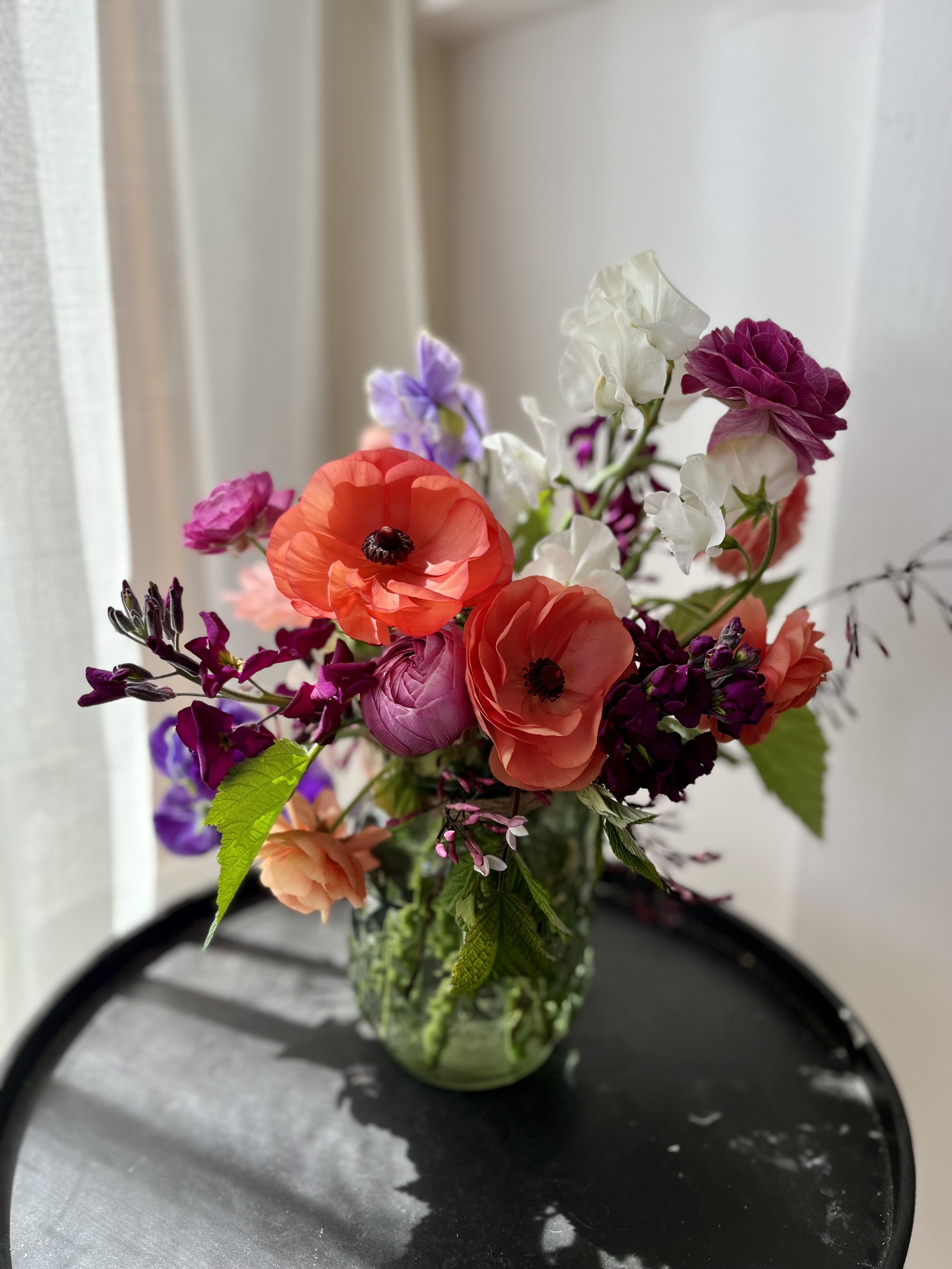The fluffy fussy who I can’t live without
Spring Wedding Flowers: Ranunculus
Ah yes…. the most romanticized flower in the spring line up. Ranunculus are a beautiful addition to any garden or floral arrangement, and rightful sought after by brides for decades. With their soft, voluptuous petals and vibrant colors, they are a popular choice for weddings, being requested just about any time of year. However, ranunculus don’t grow all year round. In fact, they prefer a mild Mediterranean climate, and absolutely detest soil temps above 70 ° F. While you’ll find these at wholesale houses any time of year, you won’t find the variety available during the spring when local growers are producing the magical and enchanting modern colors.
Additionally, timing on procuring ranunculus is fickle at best. Since they love to grow low and slow over the winter, once a warm spell hits, it’s game-on and the season explodes with their fluffy faces, as corms eagerly push out the stems they have been storing energy for all winter long! It’s not uncommon to only get 5-6 stems off a single corm, and while that might seem like a lot, the first set of stems is almost always the largest, and most beautiful. The second and potential third sets tend to have smaller heads, and much more thin (sometimes weak) stems.
While most growers will attempt to succession plant their corms in an effort to extend their season, sometimes Mother Nature just doesn’t play fair, and the season is done within a couple of weeks, as the warm spells kick up the soil temps, and send the corms back into hibernation. When it comes to sourcing ranunculus, you can certainly find them for 8-12 weeks in the spring at the wholesaler, but it’s unlikely to find them at your local farmer for that period of time, making them a fussy addition to a flower farm who intends to use them for design work.
Now, besides their exquisite beauty, they do have a hidden super power in that, when harvested properly, they can carry quiet the vase life. I’ve had stems in the cooler for up to three weeks… But be warned, once stored for that period, and brought out into the warmth of room temp or beyond, they are going to immediately open, and that can make using them in design tricky as well. It’s best to discuss these potential issues with your florist openly, and be wary of any promises of ranunculus outside their bloom time, as the quality is likely not to standard, nor will the colors be as unique. That goes to say that even if one is able to procure them in late June, they are likely very expensive, and probably won’t match the expectations based on the price.
If you’re seeking to grow the beauties in your garden for your own enjoyment, be careful to choose the right location, with the right soil. Ranunculus flowers thrive in full sun, but do enjoy a little bit of afternoon shade to help cool them during the warming season. In addition, they must be grown in well-draining soil. If your soil is heavy, add organic amendments in an effort to improve drainage, and reduce rot, which ranunculus corms are known to do.
Ranunculus love to be planted in the fall, around October or November. The first step to success is to presoak the corms, preferably in warm water. Some may run an airiator in the water, as the additional oxygen can be beneficial to the corm, however, I’ve been growing these for a few seasons now, and haven’t found the need to do so. I simply plop them in a bowl warm water for no more than 4 hours, and change the water once during that time period. I do carefully rinse them during that water change, as well after after they are done soaking. I prefer to not bring any particles from previous storage into my own soil, especially in an effort to reduce the spread of pathogens. Space the bulbs about 6 inches apart, which gives them the room they need to flower, and reduce disease during the growing season.
Once your ranunculus flowers are planted, it's important to keep the soil moist, to continue to encourage the corms to produce roots during the darkest, coolest days. However, again, they are prone to rot, so it’s critical to not overwater them. In the case of this past winter, where California has extraordinary rainfall, I was lucky to be growing in raised beds, as the corms never sat in over saturated soil.
Ranunculus flowers usually bloom about 90 days after planting, but as I found out this year, they will hold back their blooms is the soil temps are too cold. A way to force them is to cover them with frost cloth, which will allow the soil temps to warm, and encourage the corms to send up stems even if the outside temperatures aren’t where they need to be. This year, we had such a cold and wet spring, that I didn’t get blooms until 2 months after I planted my first succession, but if I had used frost cloth, I likely would have had them when I wanted them.
When harvesting, you can get several blooms off one stem if the stem has pushed the first bloom up high enough. You can either take this as a short one, and utilize it for wearable (which is my favorite for those short stems), or you can take the entire stem.
As a reminder, you will typically only get 3-5 stems off a single corm, so there are times when it’s appropriate to cut shallow, and wait for the side blooms to push up and give you longer stems.
No matter when you decide cut and how long the stem is, you’ll have time to enjoy these gorgeous stems, and the romance that they bring to the early spring season.






